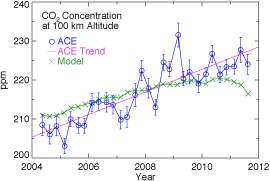Scientists detect carbon dioxide accumulation at the edge of space (Update)

(Phys.org)—A team of scientists from the Naval Research Laboratory, Old Dominion University, and the University of Waterloo reports the first direct evidence that emissions of carbon dioxide (CO2) caused by human activity are propagating upward to the highest regions of the atmosphere. The observed CO2 increase is expected to gradually result in a cooler, more contracted upper atmosphere and a consequent reduction in the atmospheric drag experienced by satellites. The team published its findings in Nature Geoscience on November 11, 2012.
The team of Dr. John Emmert, Dr. Michael Stevens, and Dr. Douglas Drob from NRL's Space Science Division; Dr. Peter Bernath from Old Dominion University; and Dr. Chris Boone from the University of Waterloo in Canada studied eight years of CO2 measurements made by the Atmospheric Chemistry Experiment (ACE), a scientific satellite mission funded primarily by the Canadian Space Agency. ACE determines vertical profiles of CO2 and many other atmospheric gases by measuring how the atmosphere absorbs sunlight at different wavelengths as the Sun rises and sets relative to the spacecraft.

CO2 occurs naturally throughout Earth's atmosphere and is the primary radiative cooling agent in the energy balance of the mesosphere (~50-90 km altitude) and thermosphere (>90 km). The same properties of CO2 that cause it to trap heat in the troposphere (<15 km) make it an efficient cooler at higher altitudes. The difference is that at high altitudes, the density of CO2 is too thin to recapture the infrared radiation (heat) that it emits. "In the upper atmosphere," explains Emmert, "thermal energy is transferred via collisions from other atmospheric constituents to CO2, which then emits the energy as heat that escapes to outer space."
The enhanced cooling produced by the increasing CO2 should result in a more contracted thermosphere, where many satellites, including the International Space Station, operate. The contraction of the thermosphere will reduce atmospheric drag on satellites and may have adverse consequences for the already unstable orbital debris environment, because it will slow the rate at which debris burn up in the atmosphere.
It has been expected that anthropogenic CO2 increases are propagating upward throughout the entire atmosphere. Before the study of ACE data, CO2 trends had been measured only up to 35 km altitude, although indirect evidence from satellite drag studies indicates that the thermosphere is indeed slowly contracting. The scientists estimate that the concentration of carbon near 100 km altitude is increasing at a rate of 23.5 ± 6.3 parts per million (ppm) per decade, which is about 10 ppm/decade faster than predicted by upper atmospheric model simulations. In comparison, tropospheric CO2 concentrations are increasing at a rate of about 20 ppm/decade (the current concentration of CO2 near the ground is ~390 ppm). The authors speculate that the larger than expected upper atmospheric trend may be caused by changes in upper atmospheric circulation and mixing.
More information: Nature Geoscience paper: DOI: 10.1038/ngeo1626
Journal information: Nature Geoscience , Nature
Provided by Naval Research Laboratory















